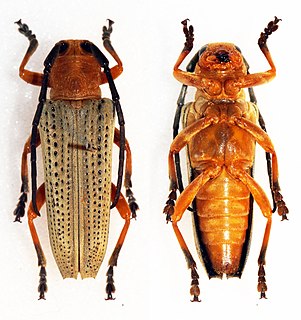Related Research Articles

A Chianti wine is any wine produced in the Chianti region of central Tuscany. It was historically associated with a squat bottle enclosed in a straw basket, called a fiasco. However, the fiasco is only used by a few makers of the wine as most Chianti is now bottled in more standard shaped wine bottles. Baron Bettino Ricasoli created the Chianti recipe of 70% Sangiovese, 15% Canaiolo and 15% Malvasia bianca in the middle of the 19th century.

The red-crested pochard is a large diving duck. The scientific name is derived from Greek Netta "duck", and Latin rufina, "golden-red". Its breeding habitat is lowland marshes and lakes in southern Europe and it extends from the steppe and semi-desert areas on the Black Sea to Central Asia and Mongolia, wintering in the Indian Subcontinent and Africa. It is somewhat migratory, and northern birds winter further south into north Africa.

Saints Justa and Rufina (Ruffina) are venerated as martyrs. They are said to have been martyred at Hispalis (Seville) during the 3rd century.
Rufina Ubah is a former Nigerian sprinter who specialised in the 100 metres.

Rufina and Secunda were Roman virgin-martyrs and Christian saints. Their feast day is celebrated on 10 July.

The Diocese of Porto–Santa Rufina is a suburbicarian diocese of the Diocese of Rome and a diocese of the Catholic Church in Italy. It was formed from the union of two dioceses. The diocese of Santa Rufina was also formerly known as Silva Candida.

The little red brocket or swamp brocket, also known as the Ecuador red brocket, is a small, little-studied deer native to the Andes of Colombia, Ecuador and northern Peru, where found in forest and páramo at altitudes between 1,400 and 3,600 metres. It is one of the smallest brocket deer. The coat is reddish, and the legs and crown are blackish. As recently as 1999, some authorities included both the pygmy brocket and Merida brocket as subspecies of the little red brocket.

Saperdini is a tribe of longhorn beetles of the subfamily Lamiinae.

Stibara is a genus of longhorn beetles of the subfamily Lamiinae, containing the following species:
Stibara cambodjensis is a species of beetle in the family Cerambycidae. It was described by Masao Hayashi in 1964.
Stibara humeralis is a species of beetle in the family Cerambycidae. It was described by James Thomson in 1865. It is known from Myanmar.
Stibara lateralis is a species of beetle in the family Cerambycidae. It was described by James Thomson in 1865. It is known from Myanmar.
Stibara morbillosa is a species of beetle in the family Cerambycidae. It was described by Johan Christian Fabricius in 1798, originally under the genus Saperda. It is known from India.

Stibara nigricornis is a species of beetle in the family Cerambycidae. It was described by Johan Christian Fabricius in 1781.
Stibara nigrovittata is a species of beetle in the family Cerambycidae. It was described by Stephan von Breuning in 1954. It is known from Myanmar and India.
Stibara subpunctata is a species of beetle in the family Cerambycidae. It was described by Stephan von Breuning in 1954.
Stibara suturalis is a species of beetle in the family Cerambycidae. It was described by Charles Joseph Gahan in 1890. It is known from India.

Stibara tetraspilota is a species of beetle in the family Cerambycidae. It was described by Frederick William Hope in 1840. It is known from Thailand, Myanmar, India, and Vietnam.

Stibara tricolor is a species of beetle in the family Cerambycidae. It was described by Johan Christian Fabricius in 1792, originally under the genus Saperda. It is known from Myanmar, India, China, Thailand, Malaysia, and Vietnam.
Stibara trilineata is a species of beetle in the family Cerambycidae. It was first described by Frederick William Hope in 1840.
References
- ↑ BioLib.cz - Stibara rufina. Retrieved on 8 September 2014.
| This Saperdini article is a stub. You can help Wikipedia by expanding it. |